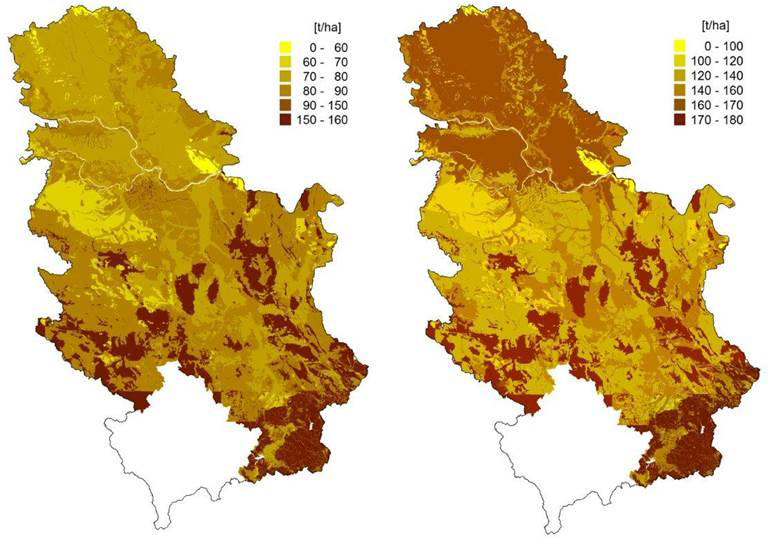Institution/Author: Environmental Protection Agency/dr Dragana Vidojević
Assessment: Spatial distribution of soil organic carbon (SOC) were investigated in the soils of the Republic of Serbia (Vidojević et al., 2017). The database included a total of 1,140 soil profiles which corresponded to 4,335 soil horizons. To establish the relationship between organic carbon content and soil type, a soil map of Serbia was adapted to the WRB classification and divided into 15,437 polygons (map units). We calculated the SOC stock values for each reference soil group based on mean values of SOC at 0-30 and 0-100 cm and their areas. The largest SOC stocks for the soil layers 0-30 cm were found in Cambisol 194.76 x 1012 g and Leptosol 186.43 x 1012 g, and for the soil layers 0-100 cm in Cambisol 274.87 x 1012 g and Chermozem 230.43 x 1012 g. Based on the size of the reference groups, total area of Republic of Serbia, and the mean SOC values for each reference group, we calculated the total SOC stocks. The obtained values for the soil layers 0-30 cm and 0-100 cm amounted to 705.84 x 1012 g and 1,159.55 x 1012 g, respectively. The spatial distribution of organic carbon stocks and its variability is caused by various factors, such as clay content, land use pattern, altitude, and climate. In general, the distribution of the content of organic carbon at 0-30 cm showed higher values in Central Serbia, where forestland occupied a larger area than agricultural land. This study is the first comprehensive assessment of organic carbon stocks in the soils layers 0-30 cm and 0-100 cm done in the Republic of Serbia. The compilation of data on organic carbon stocks and its distribution in the different soil reference groups is the first step in the evaluation and monitoring of changes of organic carbon stocks in the soils of Serbia.

References:
Vidojević, D., edt. 2016. Agriculture and environment in the Republic of Serbia – Indicators based report, Ministry of Agriculture and Environmental Protection – Environmental protection Agency, Poljoprivreda i životna sredina u Republici Srbiji – Indikatorski prikaz. Ministarstvo poljoprivrede i zaštite životne sredine, Agencija za zaštitu životne sredine. ISBN 978-86-87159-11-2 (online) http://www.sepa.gov.rs/download/publikacije/Poljoprivreda_2016.pdf
Vidojević, D, Baćanović, N, Dimić, B. 2017. The state of the soil in the Republic of Serbia. Ministry of Agriculture and Environmental Protection – Environmental Protection Agency. Izveštaj o stanju zemljišta u Republici Srbiji, Ministarstvo poljoprivrede i zaštite životne sredine, Agencija za zaštitu životne sredine, ISSN 2334-9913 (Print) ISSN 2466-2968 (Online) http://www.sepa.gov.rs/download/zemljiste/Zemljiste_2015.pdf
Vidojević, D., Manojlović, M., Đorđević, A., Nešić, Lj., Dimić, B. 2017. Spatial distribution of soil organic carbon stocks in Serbia. FAO 2017. Proceedings of the Global Symposium on Soil Organic Carbon 2017. Food and Agriculture Organization of the United Nations. Rome, Italy, p. 195-198